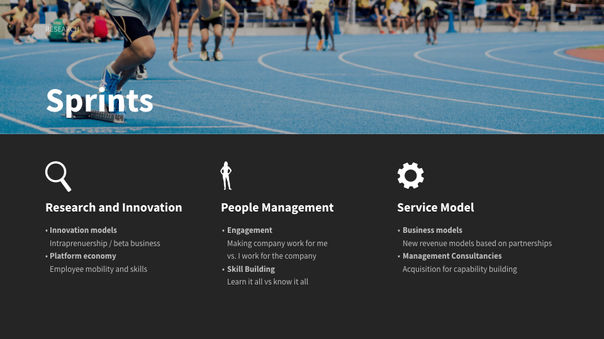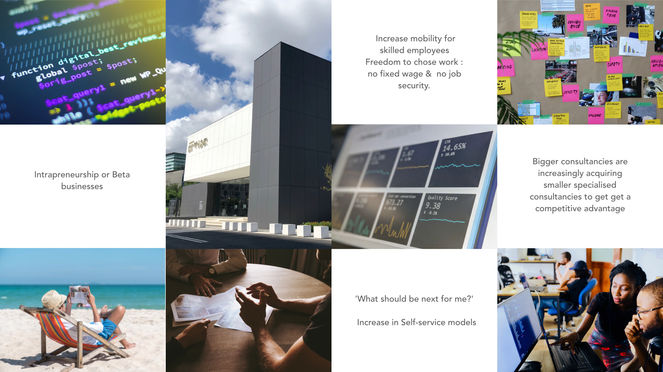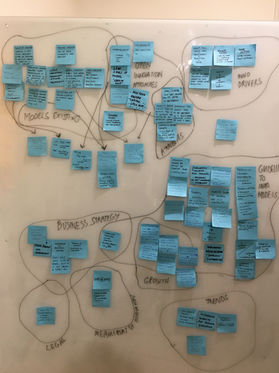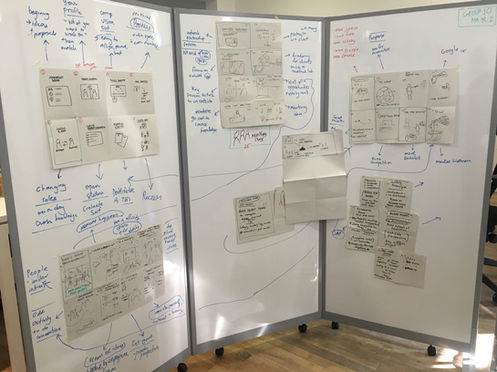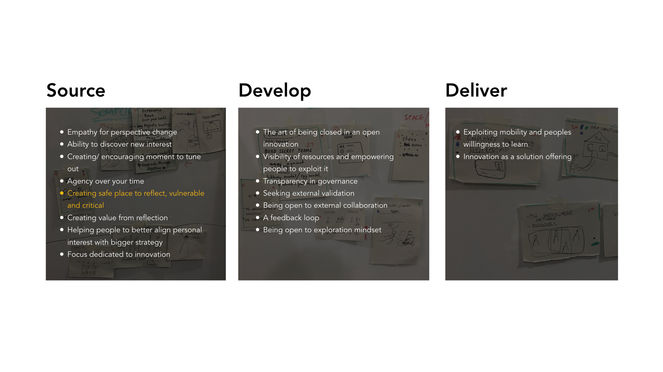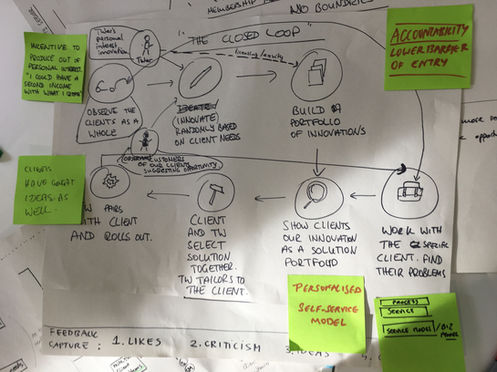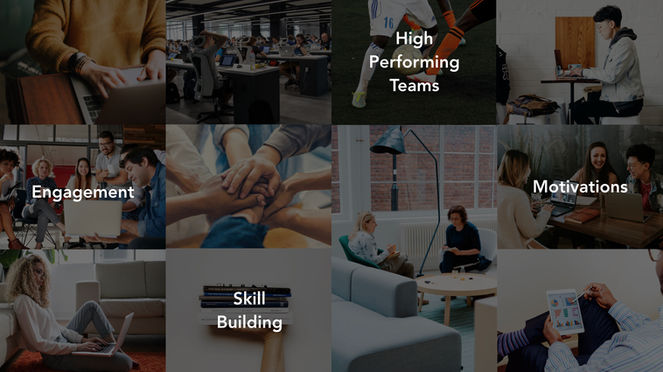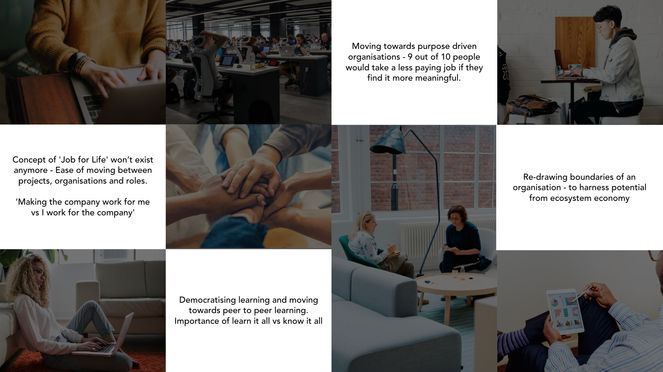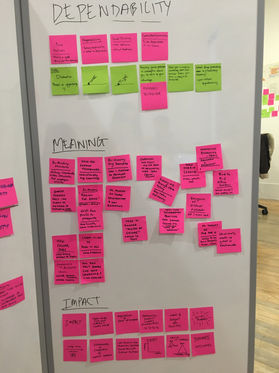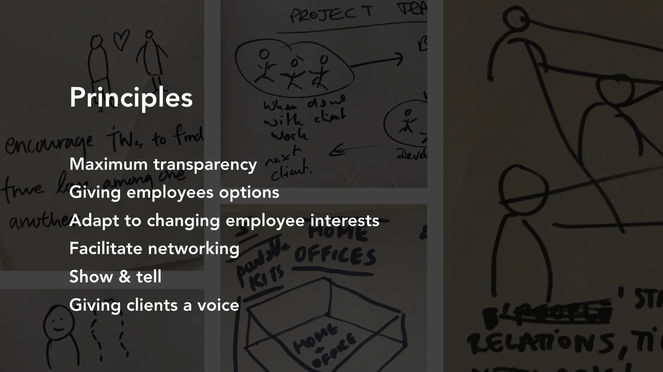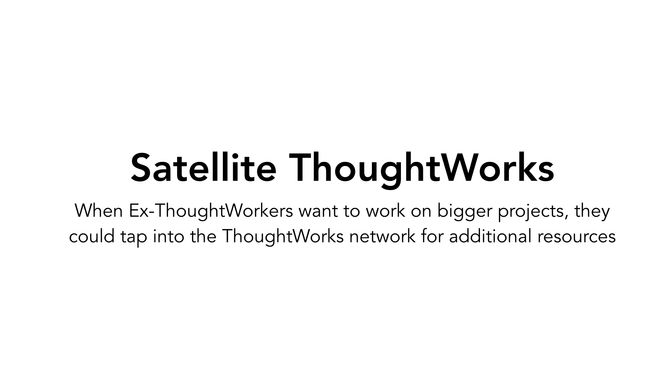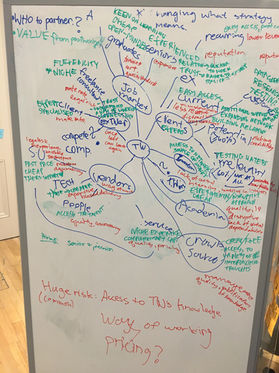Roobik's - Future of Consulting Services
An employee digital service that helps a leading Software and Technology Consultancy grow sustainably by aligning employees’ individual growth and the organisations’ growth.
In Collaboration with

Type
Design Strategy
User Research
Speculative Design
Duration
10 Weeks
Team
5 People
Area
Adaptable Organisations
Organisational Design
Platform Economy
Governance and Accountability

An Expectation Management Tool for Consultancies
Roobiks
Roobiks ensures a two-way interaction between senior management, project managers, and employees by making use of digital tools, as well as physical artifacts as conversation starters and means to provide the necessary information.
Roobiks identifies employees’ career trajectory and interests to provide them with the most suitable projects while also assisting senior managers and project managers to make better informed decisions when sourcing new projects.
Roobiks is designed for senior management, project managers, as well as employees of all levels.
Main Features

Capturing Interest
While waiting to be deployed onto their next client project, employees are encouraged to type in their personal interest, professional capability and professional interest and to print out and stick this sticker onto their devices.
This sticker works as a conversation starter and enhances knowledge exchange between employees. Every time an employee prints out a sticker, the data captured across these 3 areas is automatically fed into the 'employee interests overview' of project sourcing teams, enable them to make better-informed decisions.

Informed demand
Project sourcing teams can now see employees' interests and strategically source projects based on this information.
When finishing working on a client project, employees estimate the impact the project had across the already existing key company values. Project sourcing teams can then access a collective impact estimation of each project and evaluate the disparity.

Types of Projects
With the available data, project sourcing teams can now diagnose projects based on Market Demand, Capability, and Employee Interest. Within Roobiks we are focussing on
2 kinds of projects :-
Performance projects : These are the projects that ThoughtWorks's existing capability can do and there is a Market Demand, however, employees are not interested.
Learning Projects : Interesting for employees and there is a Market Demand but ThoughtWorks currently doesn’t have the capability to execute it. For eg: 10 ThoughtWorkers, one or more ThoughtWorkers that are not billed to the client will be added with the intention of learning. Employees are encouraged to develop new capabilities to eventually perform as a billable individual in the future.
Context




Mapping the Landscape
Future Trends

What does growth currently mean to ThoughtWorks?
We conducted several in-depth interviews with employees at various levels of seniority in the organisation. This is what we identified:
From a management perspective :
Scaling : Growth means scaling in terms of headcount and aiming to generate their core revenue from the top 10 UK clients.
From an employee perspective,
Capital : it means growing social and knowledge capital through digital channels like ’common interests groups’ or informal rituals like
‘speaker’s corner’ and 'meetups'.
Progressing in the future which aspect needs more focus? We believe bottom-up growth is a more sustainable approach.
When an individual grows, the organisation grows organically – it’s a bottom-up growth.
However, an organisation could also just grow with its employees lagging behind – which is a top-down growth. Based on the characteristics of ThoughtWorks, we identified bottom-up growth as the more sustainable approach to grow.
Growth - Overarching theme
When a Patient (Client) is sick, they would usually go seek advice from a General Practitioner (Management Consultancy). The GP would then diagnose their symptoms and give them a Prescription (Strategy) that they could take. If the problem is severe and can't be dealt with on their own, they would then seek help from a Specialist (Software Consultancy / ThoughtWorks).
Major management consultancies are trying to own the whole chain by building Hospitals (complete capabilities from strategy to solution and implementation). We then asked ourselves how a specialist like ThoughtWorks could compete in this landscape.
A project in collaboration with ThoughtWorks, UK to reimagine how their consulting services might be shaped to meet new challenges in existing markets and new ways of working in future.
We used an analogy to help us better understand the consultancy landscape. This helped us figure out how ThoughtWorks could grow.
Alligning Individual growth to organisation growth
We dived into the consultancy ecosystem and through our research, we detected the following key trends that we believed would impact the future of professional services.
Adaptable organisations - Quick to detect shifts in the operating environment, and flex appropriately.
Governance & accountability - Policies such as IR35 are changing how freelance consultants work.
Ways of working - With new technologies, there’s a constant need to learn and adapt ways of working.
Tailored solutions - White label solutions just don’t work.
Boundaries of an organisation - Leveraging external partnerships.
Sprints
Planning sprints and execution
In this project, we wanted to experiment with our methodology to execute a project of this complexity and magnitude in the best way possible.
We adopted ThoughtWorks’ way of working which is influenced by software development. We ran design sprints across 3 areas we believed we could realistically make a difference.
At the end of each sprint, we designed a broad design direction specific to ThoughtWorks.
Sprint 1 : Research & Innovation
How might we rethink growth models through insights to deliver tailored professional services to remain competitive in a platform economy?
Discover : Within the innovation landscape we raised questions like: How the needs of clients was changing in response to changes in technology and their customer behaviour? We conducted interviews with experts in the topic. We found attending events and talking to people there (“Digital Transformation Expo” and “Beta Business Maker’s Meet” hosted by Idean) also very insightful.
Define : During our ideation we broke down innovation into three phases: source, develop and deliver. We grouped the ideas that came out of the exercise. We dug deeper into the essence of the ideas and extracted the underlying ideas. It was a starting point for developing a service concept.
Develop : Looking at the underlying core of the ideas we developed and the research that we did, we came up with a service called – “Idea Cloud”.
Validate : We tested the “Idea Cloud” at a workshop with ThoughtWorkers who provided positive and constructive feedback.

Learning : Don’t over complicate a problem statement (the simpler the better), It’s difficult to develop one business function without the context of others (focus on the core but keep in mind the res), Divide into smaller groups and break each others’ ideas.
Sprint 2 : People Management
How might we align individual and organisational growth?
Discover : In our research phase for this sprint, we interviewed ThoughtWorkers, other experts and attended relevant talks and events (“Service Design Fringe Festival”). In particular, we tried to understand the building blocks of high performing teams, how we could create meaning at work and how we could build a culture around it. Moreover, we looked at motivations to work, skill building and how organisations engage their employees.
Define : We did a crazy eight exercise (everyone comes up with eight ideas in eight minutes) to get some ideas. We analysed the best ideas and created principles for our service.
Develop : ThoughtWorks is currently not harnessing the potential of its alumni network. This is why we decided to explore a partnership model of ex-ThoughtWorkers and design a new service for that – “Satellite ThoughtWorks”.
Validate : We prepared a prototype of the “Satellity ThoughtWorks” idea and validated it with ThoughtWorkers. We got a valuable feedback and understood how many challenges there are, socially with the business model of that kind of solution.

Learning : Our learning from sprint 2 are: Share research as you would like to give a lesson about that, Have a goal that you want to achieve at the end of a day, Put a cap on working hours, surprisingly you can usually make it on time, Using a framework for sharing opinions helps to express better filtered thoughts (structuring your thought cuts down unnecessary discussions).
Sprint 3 : Service Models
How can the organisational model evolve with the times?
Discover : We organised our research insights on the timeline: Before (working in ThoughtWorks), During (working in ThoughtWorks), After (working in ThoughWorks) to decide at which stage we want to intervene with our service proposition. We used different colours of post-its to distinguish insights specific for ThoughWorks from general about consulting; and these related to an organisation, from an employee, from a client.

Define : In this sprint, during the ideation, we wanted to try another approach than previously. This time, we wanted to develop less solutions but make them more detailed. We divided into two smaller groups and were developing 2 different ideas. The aim was to forget about the solutions from the previous sprints.
Develop : We had long discussions about different models of a growth strategy for the organisation; by building internal capabilities or external partnerships. Finally, we prepared user scenarios for the validating session the next day. They are all based on real users, ThoughtWorkers from our interviews.
Validate : We walked through user scenarios the Head go Growth in ThoughWorks to observe his reactions, learn more about constrains and validate initial ideas, but also see where are the most valuable opportunities for the project.

Platform Development
Post Sprint
Having all the experience and knowledge after 3 sprints, we were overloaded with the information. We realised we have to start with a blank sheet of paper to extract what is really relevant and important for developing the final solution. We sat in a white wall, empty room and wrote down concisely: a vision, a strategy and principles. We also did a simplified user journey to see where are the best opportunities.


Crazy 8 exercise helped to warm up our creative brains. We decided it should be an internal digital/physical service. Later, everyone developed a concept idividually to see others perspectives.
Success Matrix
Measurement Matrix
These are a few key metrics we thought of to evaluate the success of our proposition.

Growth strategy
We are envisioning the capability growth (in-house capability building and hiring) curve to slow down after a while once the current aggressive hiring stage is over. For employee satisfaction we will need some time for the interests to feed into the demands team to actually have an effect on the projects that they recruit. Once that stage is over we expect a stiff growth curve as employees are getting the projects they want. For revenue we are expecting a slow growth at the beginning as investment will be needed for hiring new employees and also learning projects. Then once the capabilities are built we expect a faster growth in revenue as well.

Growth matrix
With Roobiks we can grow more surgeons with same expertise. Then train the new surgeons with different expertise or come up with new services. Roobiks is enabling ThoughtWorks to grow in the bottom right quadrant, making them capable of entering a new market, come up with new products or eventually enter new markets with new products. On the viability side we explored “post care” as a potential new service offering which is relatively easy to offer to cushion overall revenue as more challenging capabilities are being build in the meantime.




